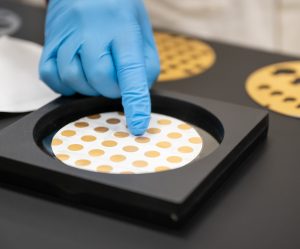
This slim but mighty film, for which a U.S. patent was issued in July 2020, was the brainchild of Kevin O’Connor, founder of Caporus Technologies. In 2018, O’Connor, who holds a Ph.D. in Electrical and Computer Engineering from the University of Missouri, founded Caporus Technologies “to have an organization dedicated to making a positive impact with this technology.”
“It is so unlike what is currently used, and the potential seemed so great,” O’Connor said of his dielectric.
O’Connor joined Chain Reaction Innovations (CRI) Cohort 3 at the U.S. Department of Energy’s (DOE) Argonne National Laboratory in June 2019. CRI is a two-year entrepreneurship program, which embeds innovators in the Lab to develop their technologies and grow their early stage companies. While embedded, O’Connor has worked with Yuepeng Zhang, a principal materials scientist at Argonne, and other technical staff across the Laboratory.
ABOUT CAPORUS
Unlike other capacitor dielectrics on the market today, which are composed of solid materials, Caporus’ dielectric incorporates a nanoscale porous structure that can store more energy in the vacuum or gas of the pores than is possible in a conventional solid. Caporus’ dielectrics can also operate at high temperatures, which both improves reliability and enables operation in many demanding power conversion applications.
Dielectrics are electrical insulators, materials that do not conduct electricity, that store energy in capacitors. Capacitors provide energy storage in power converters, which are critical systems in a wide range of applications, including electric vehicles (EVs), the transmission grid, industrial motor drives, electric vertical take-off and landing (eVTOL) aircraft, and renewable energy sources.
“It is so unlike what is currently used, and the potential seemed so great,” O’Connor said of his dielectric.
In addition to the U.S. patent that he received in July, O’Connor has reached several milestones with Caporus since joining Cohort 3. One was funding from the DOE’s National Nuclear Security Administration, which is interested in the potential of his invention in machines for clean fusion energy and high-energy physics experiments. A second was hiring the company’s first full-time employee, a materials engineer, largely paid through DOE funding. On the technical end, the company has been “proving out” the capabilities of the film to operate in high electric fields and high temperatures. Access to equipment at Argonne’s Materials Engineering Research Facility (MERF) and Center for Nanoscale Materials (CNM) has helped Caporus advance to develop small-scale prototypes in its first year with CRI.
HOW IT WORKS
Caporus’ thin-film dielectric is composed of aluminum oxide, which forms a layer-like structure with nanoscale pores, each pore less than 50 nanometers thick.
The porous structure of the dielectric film is unique, and the ability of the dielectric to operate at higher electrical fields results in smaller and lighter components. This can benefit greener modes of transportation, such as EVs.
Development of Caporus’ materials has focused on advanced manufacturing processes that are scalable and economical. The aluminum oxide is coated onto substrates as an ink that self-assembles into the porous structure. During O’Connor’s second year at Argonne, the capacitor materials will be manufactured via roll-to-roll processing to produce the material in higher volume.

IMPACT
By improving performance in power conversion systems, Caporus hopes to accelerate electrification in the US transition toward a sustainable energy economy. One example O’Connor cited is in electric vehicle charging infrastructure, where today’s long charge times are a barrier that has prevented larger scale EV adoption. Caporus’ capacitors provide a critical advancement to make charging an EV as convenient as topping off a fuel tank.
Eventually, Caporus hopes to produce its own line of capacitors, while also supplying capacitor modules that other manufacturers will integrate into larger capacitors. The company is focused on obtaining customers in medium- to high-voltage (>500 volts) markets.
“We want to be a world leader in capacitors for high- performance applications,” O’Connor said.
Kevin O’Connor is a member of cohort 3, the third class of innovators to participate in the Chain Reaction Innovations program at Argonne National Laboratory.
Chain Reaction Innovations provides innovators with laboratory tools and seed capital as well as the technical, business and manufacturing expertise needed to rapidly mature their early-stage technologies. The goal is to enable them to attract the long-term capital and commercial partners needed to scale and launch into the marketplace.
CRI is part of the Lab-Embedded Entrepreneurship Programs supported by the U.S. Department of Energy’s Office of Energy Efficiency and Renewable Energy (EERE). EERE created the Lab-Embedded Entrepreneurship Programs to provide an institutional home for innovative postdoctoral researchers to build their research into products and train to be entrepreneurs. The two-year program for each innovator is funded by EERE’s Advanced Manufacturing Office (AMO).

